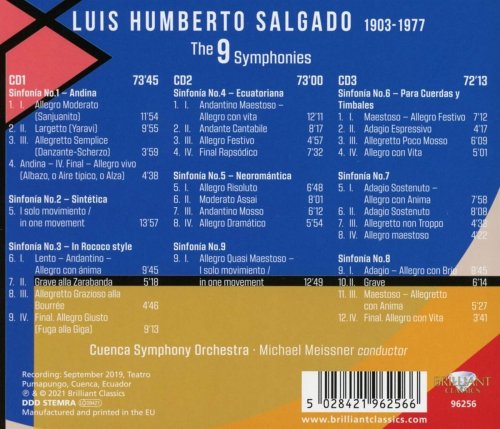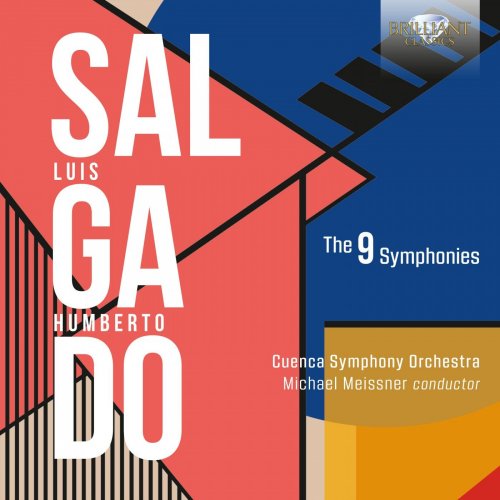
Cuenca Symphony Orchestra & Michael Meissner - Salgado: The 9 Symphonies (2021)
BAND/ARTIST: Cuenca Symphony Orchestra. Michael Meissner
- Title: Salgado: The 9 Symphonies
- Year Of Release: 2021
- Label: Brilliant Classics
- Genre: Classical
- Quality: flac lossless +Booklet
- Total Time: 03:38:54
- Total Size: 1.08 gb
- WebSite: Album Preview
Tracklist
01. Sinfonía No. 1-Andina: I. Allegro moderato
02. Sinfonía No. 1-Andina: II. Largetto
03. Sinfonía No. 1-Andina: III. Allegretto semplice
04. Sinfonía No. 1-Andina: Andina-IV. Final-Allegro vivo
05. Sinfonía No. 2-Sintética: I. solo movimiento/In One Movement
06. Sinfonía No. 3-In Rococo Style: I. Lento-Andantino -Allegro con ánima
07. Sinfonía No. 3-In Rococo Style: II. Grave alla zarabanda
08. Sinfonía No. 3-In Rococo Style: III. Allegretto grazioso alla bourrée
09. Sinfonía No. 3-In Rococo Style: IV. Final. Allegro giusto
10. Sinfonía No. 4-Ecuatoriana: I. Andantino maestoso-Allegro con vita
11. Sinfonía No. 4-Ecuatoriana: II. Andante cantabile
12. Sinfonía No. 4-Ecuatoriana: III. Allegro festive
13. Sinfonía No. 4-Ecuatoriana: IV. Final rapsódico
14. Sinfonía No. 5-Neoromántica: I. Allegro risoluto
15. Sinfonía No. 5-Neoromántica: II. Moderato assai
16. Sinfonía No. 5-Neoromántica: III. Andantino mosso
17. Sinfonía No. 5-Neoromántica: IV. Allegro dramático
18. Sinfonía No. 9: I. Allegro quasi maestoso -I solo movimiento/In One Movement
19. Sinfonía No. 6-Para cuerdas y timbales: I. Maestoso-Allegro festive
20. Sinfonía No. 6-Para cuerdas y timbales: II. Adagio espressivo
21. Sinfonía No. 6-Para cuerdas y timbales: III. Allegretto poco mosso
22. Sinfonía No. 6-Para cuerdas y timbales: IV. Allegro con vita
23. Sinfonía No. 7: I. Adagio sostenuto-Allegro con anima
24. Sinfonía No. 7: II. Adagio sostenuto
25. Sinfonía No. 7: III. Allegretto non troppo
26. Sinfonía No. 7: IV. Allegro maestoso
27. Sinfonía No. 8: I. Adagio-Allegro con brio
28. Sinfonía No. 8: II. Grave
29. Sinfonía No. 8: III. Maestoso-Allegretto con anima
30. Sinfonía No. 8: IV. Final. Allegro con vita

A nine-symphony cycle, never previously recorded: a notable first and an essential listen for fans of 20th-century symphonies.
Despite being the leading composer of his native Ecuador, the name and reputation of Luis Humberto Salgado (1903-1977) has hardly travelled beyond South America, and listeners may well wonder why after sampling the powerful and individual voice at work through the course of his nine symphonies. They stretch from 1949 to 1975: works of maturity, not outlandishly but colourfully orchestrated, originally structured (the Second and Ninth each in a single movement), nationalistically inflected, especially in several of the rackety finales, yet crafted with a fastidious ear, as one would expect from a pupil, then professor, then director of the leading conservatoire in his country, based in the capital of Quito.
The most overtly folkloristic of the symphonies is the First, in which each movement is based on a different indigenous style of music. The tendency to compression in Schoenberg’s First Chamber Symphony impressed Salgado deeply, and influenced the compact form of the Second, while more widely encouraging concision of thought and expression where many of his contemporaries incline to bombast and blather. However, Salgado never followed the likes of Messiaen and Boulez down the path of total serialism: dating from 1956, the Third Symphony bears a distinct key signature – D major – and intriguing subtitle: ‘written on a pentatonic scale in Rococo style’.
The Fourth is another vigorous assertion of Ecuadorean and Andean character within traditional symphonic form; Salgado wrote of the Fifth that ‘In my fifth symphony, titled Neo-Romantic (of course, still unpublished), I expose the first theme with twelve-tone prosody; the descriptive idea infused with a melodic climate, consistent with the hedonistic spirit that animates this score.’ The language of the Sixth (1968) is structured like a Concerto grosso and scored for strings and timpani, in the neoclassical vein of earlier European scores by Martinu and Martin.
Salgado styled the Seventh as a tribute to Beethoven on the bicentennial of his birth, but the symphony itself is strident and questing, reflecting the subject of devotion in spirit and temperament rather than pastiche. The Eighth Symphony of 1972 was composed to mark the sesquicentennial of the Battle of Pichincha, which wrested Quito and the independence of Ecuador away from their Spanish occupiers. Rather than relying on popular or even military tropes, however, Salgado continues with his mature personal style of fusing native melodic and rhythmic elements with dense, polytonal harmonies. Finally, the 12-minute Ninth makes an appropriately refined adieu, shaped around several 12-tone melodies, its exposition outlined in a mere 53 bars, and brought to a conclusion by a dense and chromatic fugato.
The project to record Salgado’s symphonies for the first time has been led by the German-Mexican maestro Michael Meissner, who also contributes authoritative and detailed booklet notes on each symphony. He draws disciplined and vividly recorded performances from the Orquesta Sinfonica de Cuenca in the historic city in the south of Ecuador.
01. Sinfonía No. 1-Andina: I. Allegro moderato
02. Sinfonía No. 1-Andina: II. Largetto
03. Sinfonía No. 1-Andina: III. Allegretto semplice
04. Sinfonía No. 1-Andina: Andina-IV. Final-Allegro vivo
05. Sinfonía No. 2-Sintética: I. solo movimiento/In One Movement
06. Sinfonía No. 3-In Rococo Style: I. Lento-Andantino -Allegro con ánima
07. Sinfonía No. 3-In Rococo Style: II. Grave alla zarabanda
08. Sinfonía No. 3-In Rococo Style: III. Allegretto grazioso alla bourrée
09. Sinfonía No. 3-In Rococo Style: IV. Final. Allegro giusto
10. Sinfonía No. 4-Ecuatoriana: I. Andantino maestoso-Allegro con vita
11. Sinfonía No. 4-Ecuatoriana: II. Andante cantabile
12. Sinfonía No. 4-Ecuatoriana: III. Allegro festive
13. Sinfonía No. 4-Ecuatoriana: IV. Final rapsódico
14. Sinfonía No. 5-Neoromántica: I. Allegro risoluto
15. Sinfonía No. 5-Neoromántica: II. Moderato assai
16. Sinfonía No. 5-Neoromántica: III. Andantino mosso
17. Sinfonía No. 5-Neoromántica: IV. Allegro dramático
18. Sinfonía No. 9: I. Allegro quasi maestoso -I solo movimiento/In One Movement
19. Sinfonía No. 6-Para cuerdas y timbales: I. Maestoso-Allegro festive
20. Sinfonía No. 6-Para cuerdas y timbales: II. Adagio espressivo
21. Sinfonía No. 6-Para cuerdas y timbales: III. Allegretto poco mosso
22. Sinfonía No. 6-Para cuerdas y timbales: IV. Allegro con vita
23. Sinfonía No. 7: I. Adagio sostenuto-Allegro con anima
24. Sinfonía No. 7: II. Adagio sostenuto
25. Sinfonía No. 7: III. Allegretto non troppo
26. Sinfonía No. 7: IV. Allegro maestoso
27. Sinfonía No. 8: I. Adagio-Allegro con brio
28. Sinfonía No. 8: II. Grave
29. Sinfonía No. 8: III. Maestoso-Allegretto con anima
30. Sinfonía No. 8: IV. Final. Allegro con vita

A nine-symphony cycle, never previously recorded: a notable first and an essential listen for fans of 20th-century symphonies.
Despite being the leading composer of his native Ecuador, the name and reputation of Luis Humberto Salgado (1903-1977) has hardly travelled beyond South America, and listeners may well wonder why after sampling the powerful and individual voice at work through the course of his nine symphonies. They stretch from 1949 to 1975: works of maturity, not outlandishly but colourfully orchestrated, originally structured (the Second and Ninth each in a single movement), nationalistically inflected, especially in several of the rackety finales, yet crafted with a fastidious ear, as one would expect from a pupil, then professor, then director of the leading conservatoire in his country, based in the capital of Quito.
The most overtly folkloristic of the symphonies is the First, in which each movement is based on a different indigenous style of music. The tendency to compression in Schoenberg’s First Chamber Symphony impressed Salgado deeply, and influenced the compact form of the Second, while more widely encouraging concision of thought and expression where many of his contemporaries incline to bombast and blather. However, Salgado never followed the likes of Messiaen and Boulez down the path of total serialism: dating from 1956, the Third Symphony bears a distinct key signature – D major – and intriguing subtitle: ‘written on a pentatonic scale in Rococo style’.
The Fourth is another vigorous assertion of Ecuadorean and Andean character within traditional symphonic form; Salgado wrote of the Fifth that ‘In my fifth symphony, titled Neo-Romantic (of course, still unpublished), I expose the first theme with twelve-tone prosody; the descriptive idea infused with a melodic climate, consistent with the hedonistic spirit that animates this score.’ The language of the Sixth (1968) is structured like a Concerto grosso and scored for strings and timpani, in the neoclassical vein of earlier European scores by Martinu and Martin.
Salgado styled the Seventh as a tribute to Beethoven on the bicentennial of his birth, but the symphony itself is strident and questing, reflecting the subject of devotion in spirit and temperament rather than pastiche. The Eighth Symphony of 1972 was composed to mark the sesquicentennial of the Battle of Pichincha, which wrested Quito and the independence of Ecuador away from their Spanish occupiers. Rather than relying on popular or even military tropes, however, Salgado continues with his mature personal style of fusing native melodic and rhythmic elements with dense, polytonal harmonies. Finally, the 12-minute Ninth makes an appropriately refined adieu, shaped around several 12-tone melodies, its exposition outlined in a mere 53 bars, and brought to a conclusion by a dense and chromatic fugato.
The project to record Salgado’s symphonies for the first time has been led by the German-Mexican maestro Michael Meissner, who also contributes authoritative and detailed booklet notes on each symphony. He draws disciplined and vividly recorded performances from the Orquesta Sinfonica de Cuenca in the historic city in the south of Ecuador.
Year 2021 | Classical | FLAC / APE
As a ISRA.CLOUD's PREMIUM member you will have the following benefits:
- Unlimited high speed downloads
- Download directly without waiting time
- Unlimited parallel downloads
- Support for download accelerators
- No advertising
- Resume broken downloads


